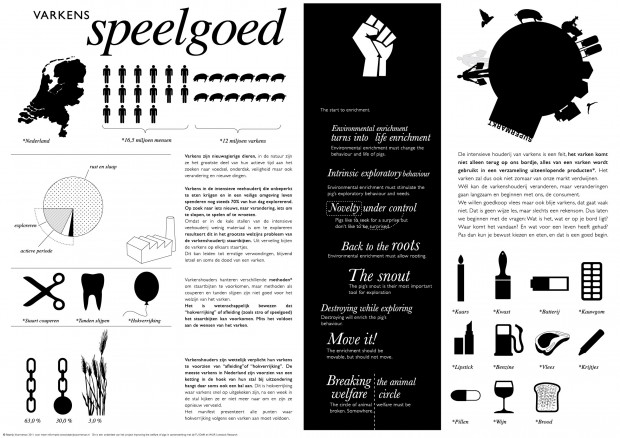At this moment there are twelve million pigs in the Netherlands, housed in the barren circumstances of the intensive farming industry. Most of these pigs are bored. Within the project “Improving the welfare of pigs” Voorneman studied the behavior of pigs. And found a way to enrich the short life of these Dutch pigs, by giving them an opportunity to express their natural behavior.This project resulted in a “pig manifesto”, presenting all the interactions pigs adore. And the concept design and tested prototype of “Sproot”, a toy for pigs.
Under natural conditions pigs spend a large part of their active time exploring their surroundings searching for food. Pigs explore their surroundings by rooting, sniffing, biting and chewing various items. In this way they become familiar with their environment.
Pigs for meat production in the Netherlands, but also in most other EU countries, are housed in barren environments, characterized by concrete flooring and lack of rooting materials. Nevertheless the pig still displays an inherent motivation to explore. However, in such cases, the behavior is directed towards other elements within the pen, namely other pigs and parts of their bodies.
Tailbiting is one of the greatest welfare concerns within intensive-pig-farming all over the world, and also the greatest cause of economic loss. To prevent tail biting, tails of newborn piglets are cut off. However, tail docking does not take away the pig’s underlying motivation to explore their surroundings. Therefore environmental enrichment should be provided, so that pigs can direct their exploring behavior to this instead of their group members. So far, practical alternative enrichment materials (such as chains, wooden bite blocks or dog toys) do not meet the requirements of pig, farmer and consumer.
The goals of this project was investigate what the natural needs of a pig are, translate these needs into product characteristics, and define the essential interaction qualities of each characteristic. By translating this interaction vision into a design, develop a solution that will stimulate pigs, in barren environments, to perform their natural exploring behavior.
Although the effect of environmental enrichment on the behavior of domesticated pigs has been studied in the livestock and animal welfare sector, never before a product (interaction) designer studied this particular subject. The designer-point-of-view, with a focus on interactions brought new insights and possibly a solution to this subject.
This project is an example of user-centered design, but in this case, the user is not a human being. In order to still be able to understand the pigs, their needs and their preferences a research-through-design approach was followed.




